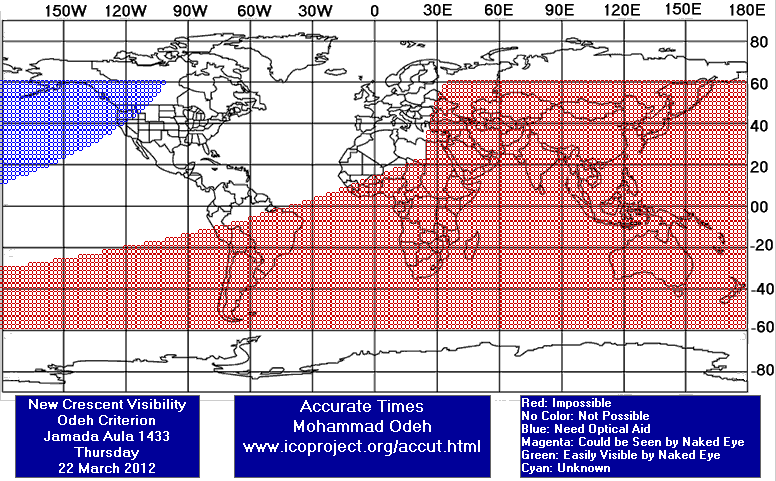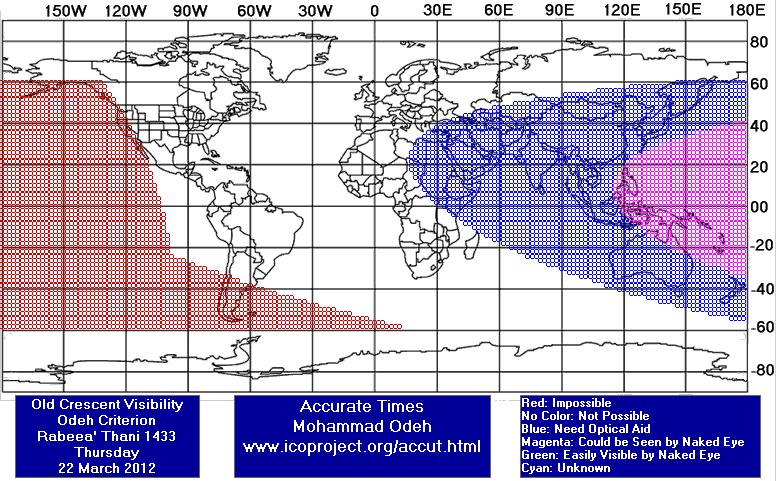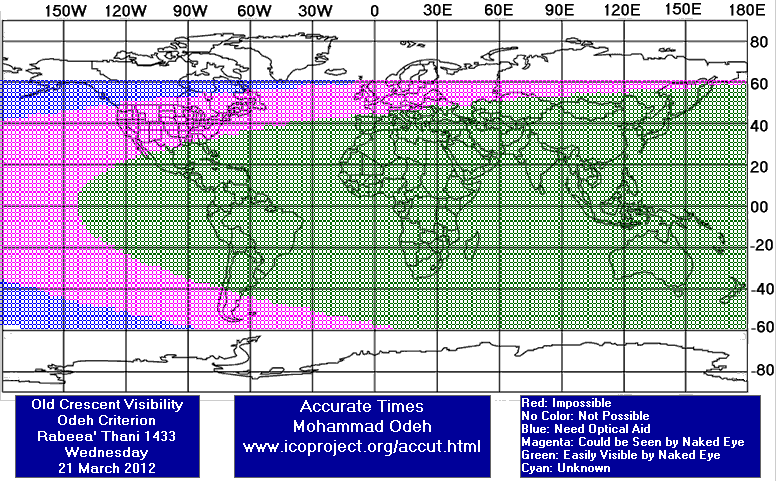نتائج رصد هلال جمادى الأولى لعام 1433 هـ
- توقع رؤية هلال أول الشهر (جمادى الأولى)
- نتائج تحري هلال أول الشهر (جمادى الأولى)
- بداية الشهر الرسمية
- توقع رؤية هلال آخر الشهر (ربيع الآخر)
- نتائج تحري هلال آخر الشهر (ربيع الآخر)
توقع رؤية هلال أول الشهر (جمادى الأولى)
سيحدث الاقتران المركزي (المحاق المركزي) يوم الخميس 22 آذار / مارس 2012 في الساعة 14:37 بالتوقيت العالمي بمشيئة الله
إمكانية رؤية الهلال يوم الخميس 22 آذار / مارس 2012 ويوم الجمعة 23 آذار / مارس 2012 موضحة في الأشكال التالية باستخدام برنامج المواقيت الدقيقة باعتماد معيار عودة، بحيث:-
- رؤية الهلال مستحيلة من المناطق الواقعة في اللون الأحمر بسبب غروب القمر قبل غروب الشمس أو/و بسبب حصول الاقتران السطحي بعد غروب الشمس.
- رؤية الهلال ممكنة باستخدام التلسكوب فقط من المناطق الواقعة في اللون الأزرق.
- رؤية الهلال ممكنة باستخدام التلسكوب من المناطق الواقعة في اللون الزهري، ومن الممكن رؤية الهلال بالعين المجردة في حالة صفاء الغلاف الجوي التام والرصد من قبل راصد متمرس.
- رؤية الهلال ممكنة بالعين المجردة من المناطق الواقعة في اللون الأخضر.
- رؤية الهلال غير ممكنة بالعين المجردة أو بالتلسكوب من المناطق غير الملونة، على الرغم من غروب القمر بعد غروب الشمس ومن حصول الاقتران السطحي قبل غروب الشمس، وذلك بسبب قلة إضاءة الهلال و/أو بسبب قربه من الأفق.
- يرجى ملاحظة أن الأشكال أدناه تبين إمكانية رؤية الهلال في المناطق الواقعة بين خطي عرض 60 شمالا و60 جنوبا.


باعتماد التقويم الهجري العالمي المبني على حساب إمكانية رؤية الهلال، فإن بداية الشهر في النطاق الشرقي تكون يوم السبت 24 آذار / مارس 2012 ، وبداية الشهر في النطاق الغربي تكون يوم الجمعة 23 آذار / مارس 2012 . الرجاء ملاحظة أن التقويم الهجري العالمي يعتمد على الحسابات المسبقة ( اي لا ينتظر الرصد العملي و رؤية الهلال ) و هو يتبنى معياراً معينا لبدء الشهر الهجري الجديد .و قد تتبنى بلدك او منظمتك معياراً آخر لبدء الشهر لذا فإننا ننصح و بشدة أن يتم الاطلاع عما جاء في صفحة التقويم الهجري العالمي في موقعنا قبل إصدار اي أحكام .
ستضاف نتائج تحري الهلال وبداية الشهر الرسمية في مختلف الدول الإسلامية في هذه الصفحة إن شاء الله فور استلام نتائج الرصد من قبل أعضاء المشروع الإسلامي لرصد الأهلة.
نتائج تحري هلال أول الشهر (جمادى الأولى)
الخميس 22 مارس 2012
المملكة المتحدة
وقال عضو المشروع المهندس قمر الدين "On Thursday, 22 March 2012 (29 Rabiul Thani 1433 AH) many people from throughout UK have attempted to sight the crescent moon (Hilal) of Jumada Al-Ula after sunset. None of the groups were able to sight the Hilal, as most places were cloudy. We have not received any reliable sighting reports (Muhaqaq-Ruyat-Basari) from any countries east of UK/Morocco either. But, we have received negative sighting report from Morocco Awqaf Ministry. Therefore, the Wifaq/Batley Ulama have decided that the month of Rabiul Thani 1433 AH will completed 30 days and the month of Jumada Al-Ula 1433 AH will start from Saturday 24 March 2012, Insha-Allah."
الولايات المتحدة
وقال عضو المشروع السيد جيم ستام "New Moon Crescent Observation Report ====================================== Observed: Thursday; March 22, 2012 - 18:48 (Local) Location (WGS 84) = Tucson, Arizona (USA) Longitude = 110.9808 W Latitude = 32.4322 N Elevation = 876 meters Time Zone = -7.0 hours Surface conditions at location: Temperature = 22 °C Humidity = 18 % Pressure = 29.84 in. Only slight haze kept the sky from being perfect. Magnitude limit at 2 degrees altitude with 80 power in C-8 telescope, after the end of twilight = 9.6 Topocentric and local time values from “Accurate Times”: Sunset (at sea level) = 18:42 Moonset (at sea level) = 19:06 Time from new moon at 18:48 = 12 hr. 17 min. Moon lag time = 24 min. Relative Altitude = 4.9 degrees Elongation from sun = 6.0 degrees Crescent width = 5 arc seconds Illumination = 0.28 percent Crescent first observed through 8” SC telescope: Time = 18:48 Moon Altitude = 1.5 degrees Crescent last observed through 8” SC telescope: Time = 18:54 Moon Altitude = 0.6 degrees I set up the telescope on the morning before, and pre-pointed it to the moon’s position for 18:45 that evening. The magnitude limit at 2 degrees altitude with 80 power in the C-8 telescope, before the beginning of twilight was a little better than 10. After 4 minutes at the eyepiece, I was pretty sure that I saw the crescent, but it didn’t remain, and it was lower in the field than I expected. Several seconds later the image returned, and in the same place. I asked a neighbor to take a look, but he couldn’t see anything. Returning to my focus, the image returned at the same place, so I asked another neighbor to attempt to see it. She also failed. This happened again with a third observer, and I then centered the image, and it remained a little longer. However, a fourth person also failed to see anything. This was all expected, because there was no time to focus other observers, and none of them were experienced. The image, besides being lower than it should have been, also had a longer arc than I expected. It wavered too much to measure it, but my impression was that it approached 60°, and there was no section that ever looked thicker than any other. Each time the crescent displayed itself, it was hairline thin, but so soft in illumination that it seemed to blend into the orange-pinkish sky. I was so involved in trying to get others to see the crescent that I failed to note the time that it set. However, my finder showed that it was about 2.5 degrees in declination above a roof at 18.45, so it probably set around 18:55. On the way home, I realized that the reason for the image to appear lower in the scope (higher in the sky) was that atmospheric refraction had increased, with the moon being lower than at the pre-pointed position. This was my first confident observation where the image of the crescent was only intermittently visible. Observer: Jim Stamm E-mail Address: StammJim@gmail.com"
الجمعة 23 مارس 2012
الجزائر
وقال عضو المشروع السيد محمد عيسى موسى "بمشاركة أعضاء الجمعية تم مشاهدة الهلال وباستعمال أداة ساعدتنا ل لتحديد المكان التقريبي للهلال وكذا برامج المحاكاة "
وقال عضو المشروع السيد حسين الشيخ عيسى "(10) persons were present in N'tissa station with two binoculars. (7*50)/(8*50) The new crescent of Jumadal Awwal 1433 was not seen by naked eyes and not seen by a binocular,the first seen by binoculars. The Sky Near The Western Horizon Was Partly Cloudy." "
العراق
وقال عضو المشروع الدكتور عبدالستار محمد خضر "The crescent sighting was tried just after sunset ~18:20. A group of 6 persons had seen the crescent about 18:50. The color of moon was orange slightly brighter than the horizon which was of the same color. The position of moon was calculated using Redshift 6. The actual position was roughly estimated on site. The first sighting could occur earlier (perhaps more than 5 minutes ) if the position was estimated accurately."
ألمانيا
وقال عضو المشروع المهندس جيرهارد أحمد كوفمان "Crescent was easily seen by binoculars about 25 minutes after sunset - nearly vertical above the sun (a very rare position in my geographical latitude), very thin and with a visible arc of only about 120°. Visibility by naked eyes was possible some minutes later but became more and more difficult because of some haze over the horizon."
وقال عضو المشروع المهندس مارتن إليسياسر "The day had strong haze, so the skies were rather whitish. I started two hours before sunset and could immediately find and follow the crescent with the imaging system. Visual observation did not succeed, until 15 minutes before sunset, when i finally found the crescent with a small telescope at 42x magnification. With the sun going down the view improved and the crescent gradually became visible in binoculars and finally to the naked eye. Due to the strong haze it was not possible to see/image the earthshine."
المجر
وقال عضو المشروع الدكتور أبو أمينا "Esselamu aleikum! Dr. Abu Amina from Hungary"
المملكة العربية السعودية
الولايات المتحدة
وقال عضو المشروع الدكتور جواد تورابنيجاد "I arrived at my sighting location at 7:35 pm EDT (sunset: 7:36 pm) and started scanning the cloudy western horizon, hoping for clear patches to appear. That did not happen! I stayed there till 8:00 pm (moonset: 8:54 pm)."
أندونيسيا
إيران
وقال عضو المشروع السيد علي رضا مهراني "Location: Esfahan, Iran Latitude: 32° 37' N Longitude: 51° 35' E Elevation: 1621 meters from sea level Time zone: +4.5 Observer & photographer: Alireza Mehrani Date: Friday March 23, 2012 (Farvardin 4, 1391) Temperature: 13 C° (55.4 F°) Wind: 14.4 km/h Humidity: 11% Barometer: 844.4 mb Visibility: 10 km Topocentric and local time values from "Moon Calculator" (Refrac off): Crescent first observation through 7x50 binoculars: Time: 19:31 LT (15:01 UT) Moon Alt: 7° 13' 19" Sun Alt: - (3° 40' 33") Elongation: 11° 06' 22" Rel Azi: 2° 08' 39" Moon Width: 0.28' Moon Phase: 1.09% Moon Age: 24h 24m after conjunction Crescent first observation through naked eyes: Time: 19:44 LT (15:14 UT) Moon Alt: 4° 35' 58" Sun Alt: - (6° 24' 07") Elongation: 11° 11' 33" Rel Azi: 2° 03' 45" Moon Width: 0.28' Moon Phase: 1.11% Moon Age: 24h 37m after conjunction Crescent last observation through naked eyes: Time: 19:52 LT (15:22 UT) Moon Alt: 2° 59' 29" Elongation: 11° 14' 47" Crescent last observation through 7x50 binoculars: Time: 20:03 LT (14:56 UT) Moon Alt: 0° 47' 23" "
باكستان
وقال عضو المشروع السيد علام سلطان "Today (Friday, 23 March 2012= Pakistan: 29 Rabee-uth-Thani 1433) on my request, nearly 100 persons ( members of the moon-sighting committees of our institute "JAMIA-TUR-RASHEED" + my friends + their companions) tried to sight the moon all over Pakistan nearly at 15 places but the moon could not be sighted. It was clear or little hazy generally. Note 1: Chairman of central official moon sighting committee of Pakistan mufti Munee-bur-Rahman told me on my mobile phone that as he also did not receive any positive report hence he officially announced that Saturday 24th March 2012 is 30th Rabee-uth-Thani 1433 and Sunday 25th March 2012 is 1st Jumadal-oola 1433 AH in Pakistan Note 2: Inshaallah, a detailed report of this observation will be available soon in Urdu. "
بنغلادش
عُمان
وقال عضو المشروع الأستاذ دكتور محمد سالم البوسعيدي "Due to prevailing adverse dust conditions the crescent moon was not sighted even by CCD imaging. The Sun could not be seen almost 15 minutes it set."
لبنان
وقال عضو المشروع السيد اسماعيل بحسون "We had an error in aligning the telescope and we succeeded to see it at 18h28mn The crescent in the photo was slightly covered by hazes and clouds near the horizon "
نيجيريا
وقال عضو المشروع الدكتور ساني مصطفى "The waning for R.Thani was last seen on the 27th at 6.06 a.m corresponding to tuesday 20/03/2012. The moon was not sighted the next day that could be after 7.00a.m."
السبت 24 مارس 2012
أندونيسيا
وقال عضو المشروع السيد سوجنج رياضي "On Saturday (March 24, 2012); We are three Teachers (ustadz Asyhuri, Ustadzah Sirikit, and me) and also about 30 students of CASA (Astronomy Club of Assalaam Students) male and female students tried to observe the new crescent of Jumadal Ula 1433 AH on the Assalaam Observatory-The Islamic Modern Boarding School ASSALAAM - Surakarta Indonesia. And the result : The New Crescent of Jumadal Ula 1433 AH was NOT SEEN."
بداية الشهر الرسمية
السبت 24 مارس 2012
1 . المملكة العربية السعودية
2 . المملكة المتحدة
3 . أندونيسيا
4 . إيران
5 . عُمان
الأحد 25 مارس 2012
1 . باكستان
2 . بنغلادش
توقع رؤية هلال آخر الشهر (ربيع الآخر)
سيحدث الاقتران المركزي (المحاق المركزي) يوم الخميس 22 آذار / مارس 2012 في الساعة 14:37 بالتوقيت العالمي بمشيئة الله
إمكانية رؤية هلال آخر الشهر يوم الخميس 22 آذار / مارس 2012 ويوم الأربعاء 21 آذار / مارس 2012 موضحة في الأشكال التالية باستخدام برنامج المواقيت الدقيقة باعتماد معيار عودة، بحيث:-
- رؤية هلال آخر الشهر مستحيلة من المناطق الواقعة في اللون الأحمر بسبب شروق القمر بعد شروق الشمس أو/و بسبب حصول الإقتران السطحي قبل شروق الشمس.
- رؤية هلال آخر الشهر ممكنة باستخدام التلسكوب فقط من المناطق الواقعة في اللون الأزرق.
- رؤية هلال آخر الشهر ممكنة باستخدام التلسكوب من المناطق الواقعة في اللون الزهري، ومن الممكن رؤية الهلال بالعين المجردة في حالة صفاء الغلاف الجوي التام والرصد من قبل راصد متمرس.
- رؤية الهلال ممكنة بالعين المجردة من المناطق الواقعة في اللون الأخضر.
- رؤية الهلال غير ممكنة بالعين المجردة أو بالتلسكوب من المناطق غير الملونة، على الرغم من شروق القمر قبل شروق الشمس ومن حصول الإقتران السطحي بعد شروق الشمس، وذلك بسبب قلة إضاءة الهلال و/أو بسبب قربه من الأفق.
- يرجى ملاحظة أن الأشكال أدناه تبين إمكانية رؤية الهلال في المناطق الواقعة بين خطي عرض 60 شمالا و60 جنوبا.


نتائج تحري هلال آخر الشهر (ربيع الآخر)
الأربعاء 21 مارس 2012
الجزائر
ألمانيا
وقال عضو المشروع المهندس مارتن إليسياسر "Despite some light haze the crescent could be seen with the naked eye. In binoculars, it was a very nice sight."
أندونيسيا
وقال عضو المشروع السيد سوجنج رياضي "On Wednesday (March 21, 2012); the old crescent of Rabiul Akhir 1433 AH was SEEN from Assalaam Observatory The Islamic Modern Boarding School ASSALAAM - Surakarta Indonesia. We are about 20 students of CASA (Astronomy Club of Assalaam Students) More our activity: http://blogcasa.wordpress.com"
إيران
وقال عضو المشروع السيد علي رضا مهراني "Location: Tehran, Iran Latitude: 35° 39' 46.57" N Longitude: 51° 28' 18.02" E Elevation: 1147 meters from sea level Time zone: +4.5 Observer & photographer: Alireza Mehrani Date: Wednesday March 21, 2012 (Farvardin 2, 1391) Topocentric and local time values from "Moon Calculator" (Refrac off): File: amehrani March 21, 2012 old.jpg Time: 06:36 LT (02:06 UT) Moon Alt: 5° 18' 42" Sun Alt: - (6° 57' 46") Elongation: 17° 17' 29" Rel Azi: 12° 12' 14" Moon Width: 0.68' Moon Phase: 2.45% Moon Age: 36h 31m before conjunction "
نيجيريا
الخميس 22 مارس 2012
الجزائر
وقال عضو المشروع السيد عبد الواحد ديليه "بسم الله الرحمن الرحيم في صباح هذا اليوم حاولت رصد هلال آخر شهر ربيع الأول من منزلي بمدينة بريكة و لكن أفق السماء الشرقي كان مغطى بالغيوم فلم أتمكن من رصد الهلال. "





